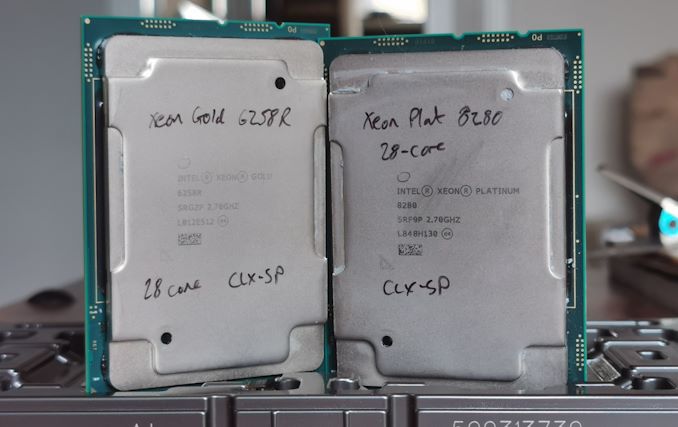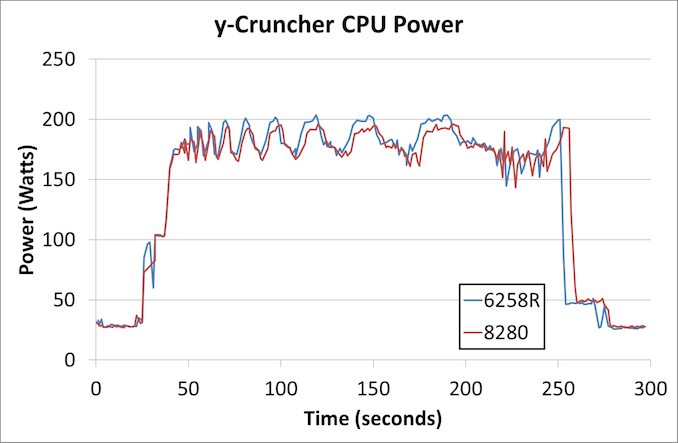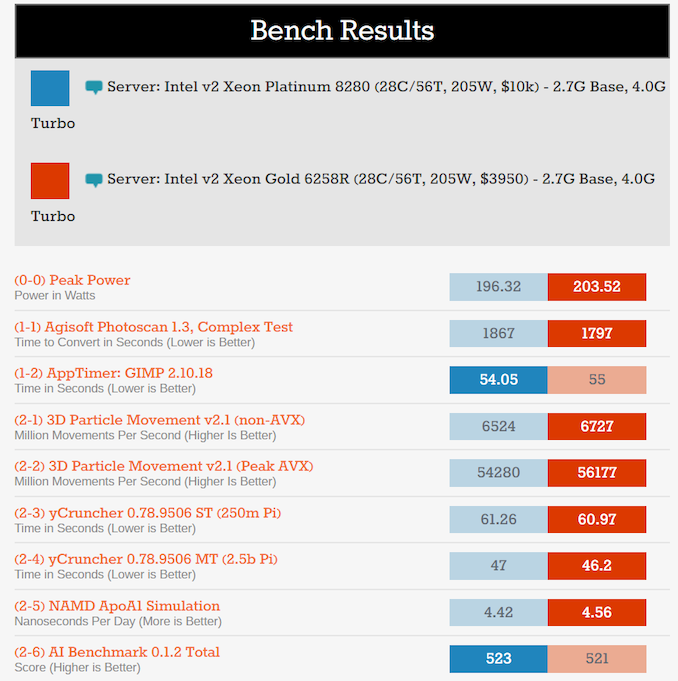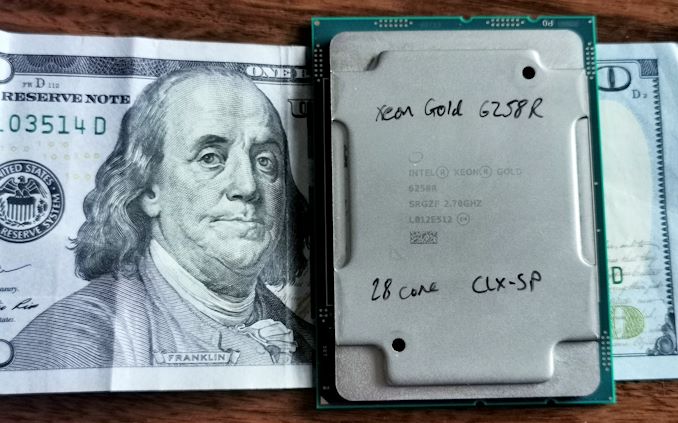
Original Link: https://www.anandtech.com/show/15955/how-to-save-6000-dollars-intel-xeon-8280-vs-6258r
How to Save $6000 on a 28-core Flagship Intel Xeon: Platinum 8280 vs Gold 6258R
by Dr. Ian Cutress on August 7, 2020 8:00 AM EST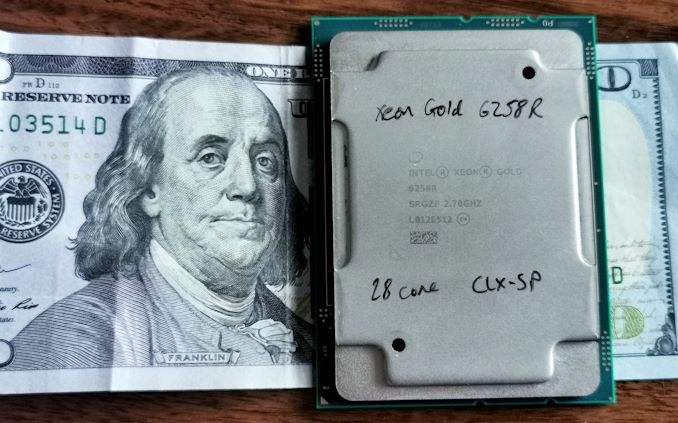
In February 2020, Intel launched eighteen new Xeon Scalable second generation processors. These mid-cycle additions to Intel’s product portfolio were designed to bolder up Intel’s server offerings on a very popular and very successful platform, adding in extra cores, extra frequency, or more cache than the previous offerings at roughly the same price. The goal of these ‘performance-oriented’ processors was to address customer requests in offering a more palatable performance-per-dollar offering. One of the new CPUs caught our eye: the Xeon Gold 6258R.
Skylake, Cascade Lake, Refresh
Colloquially known as ‘Cascade Lake Refresh’, these processors are the same silicon as the second generation Cascade Lake Xeon Scalable processors that were originally launched in April 2019. In most cases, the Refresh processors focus on both performance and performance-per-dollar metrics, especially given that Intel’s competition in this space were in a very competitive position and focusing on those values. Despite Intel’s data center revenue growing rapidly through 2019 and into 2020, there was a need to effectively replace or add new products into the areas where Intel believed it could keep a strong grasp on the customer base.
In our original announcement for the refresh parts, Intel touted an average performance gain of 36%, and a performance-per-dollar of 42%, although that was pictured as a 1st Gen to 2nd Gen Xeon Scalable jump. For a lot of the eighteen new processors on offer, they either added extra cores, more cache, or more frequency for the same cost as the parts they effectively replace. This usually comes with an increase in power consumption (there’s no escaping the physics), given there was no actual change to the underlying silicon, it simply was a function of binning and product margin.
One of the new parts was the Xeon Gold 6258R, with the R indicating ‘Refresh’. This processor was actually the highest core count refresh part, offering 28 cores at 2.7 GHz base and 4.0 GHz turbo within 205W.
For anyone who follows Intel’s server processor portfolio, those specifications look *very* familiar. Looking through the list, there is one very popular processor that has the exact same specifications: the Xeon Platinum 8280. Here’s the full breakdown:
| Intel 2nd Generation Xeon Scalable 28-Core Comparison |
||
| Platinum 8280 |
AnandTech | Gold 6258R |
| 28 Cores / 56 Threads | Cores / Threads | 28 Cores / 56 Threads |
| 2700 MHz | Base Frequency | 2700 MHz |
| 4000 MHz | Turbo Frequency | 4000 MHz |
| 38.5 MB | L3 Cache | 38.5 MB |
| 3 x 10.4 GT/s | UPI Links | 3 x 10.4 GT/s |
| 8 | Max Socket Suport | 2 |
| 6 x DDR4-2933 | DDR4 Support | 6 x DDR4-2933 |
| 1 TB | DDR4 Capacity | 1 TB |
| LGA3647 | Socket | LGA3647 |
| 205 W | TDP | 205 W |
| $10009 | List Price | $3950 |
The Platinum 8280 and the Gold 6258R are identical, almost to a fault. The same cores, the same frequency, the same power, and both support Optane DCPMM. The implementation difference is very subtle: where the 8280 supports 8-way socket deployments, the 6258R only supports 2-way. Intel has separated up the 8200 series and the 6200 series in this sole difference of socket support, which is actually more a firmware difference than anything else.
Oh, and the 6258R has a list price over $6000 cheaper.
Now, the reason why this is important comes down to where the 8280 sits in Intel’s Xeon portfolio. It is, for all intents and purposes, the processor that gets the most attention. It sits at the top of its public processor offerings*, it offers the most cores, and the list price is $10009**. If a non-technical executive is requesting ‘the best’ hardware for deployment, they naturally scroll to the most expensive part and add-to-basket. That processor would be the Xeon Platinum 8280.
However, most servers are single socket and dual socket, which essentially nullifies the ‘extra’ 4-socket and 8-socket capability that the Xeon 8280 offers. In this case, Does the 6258R, with the same specifications on core count, frequency, and power, perform the same as the 8280 but at a fraction of the price?
This is the question I set out to answer with access to both CPUs. Saving $6000 per single socket server, or $12000 in a dual socket configuration, would allow purchasers to focus that investment in other areas, such as memory or storage, or bring down the cost of purchasing quite considerably.
Footnotes
*Intel also offers a Xeon Platinum 8284 which also has the 28 cores that the 8280 does but is at a higher base frequency (same turbo) and 240W TDP. The list price is $15460, a +50% jump. This processor doesn’t seem to always be available everywhere, plus it was also launched months after the 8280.
**List prices from Intel are usually set as the price if someone buys 1000 units, so one would expect the individual cost would be slightly higher. However, major OEM partners and big hyperscalers rarely pay the list price, and the separate pricing is negotiated by contract. Rumors are that the big companies that might need a 100k units or more rarely pay more than 20-50%% of the list price. Exact figures are hard to come by.
Test Bed and Benchmarks
For this test, we’ve run through our updated suite of benchmarks, as part of our #CPUOverload project. As this isn’t a strict review of the processors, more of a comparison article to see if they perform the same, then each benchmark is relatively binary– yes it performs the same, or no they don’t (and which one is better). For these tests, we fired up our single socket LGA3647 testbed.
| AnandTech LGA3647 Test Bed | |||||
| AnandTech | COLUMN | ||||
| CPU | Intel Xeon Platinum 8280 Intel Xeon Gold 6258R |
28C/56T 28C/56T |
2.7-4.0G 2.7-4.0G |
205W 205W |
$10009 $3950 |
| Cooling | Asetek 690LX-PN (500W) | ||||
| Motherboard | ASUS ROG Dominus Extreme (0601) | ||||
| DRAM | SKHynix 6 x 32 GB DDR4-2933 | ||||
| SSD | Crucial MX500 1TB | ||||
| PSU | EVGA 1600T2 | ||||
| GPU | Sapphire RX460 | ||||
| Chassis | Anidees Crystal XL | ||||
Both processors were tested on 192 GB of SK-Hynix DDR4-2933 RDIMMs, and a sufficient 500W liquid cooling configuration.
For non-performance benchmark related data, we saw both CPUs score the same average core-to-core latency (8280 was 45.8 ns, 6258R was 45.6 ns), both CPUs get to turbo from idle to max in 35-38 milliseconds, and power consumption was almost identical.
There is a slight variation here, though this could just be down to the specific voltage characteristics of the chips I have. The 6258R hits nearer the 205 W TDP that both chips have.
For the performance benchmarks, don’t get too excited all at once. We’ll mark any performance difference as significant where a >4% change is observed.
| Intel Xeon Scalable 2nd Gen Shootout | |||
| AnandTech | Platinum 8280 |
Gold 6258R |
Performance 6258R vs 8280 |
| Office | |||
| Agisoft 1.3 | 1867 sec | 1797 sec | 103.8% |
| AppTimer GIMP | 54.1 sec | 55.0 sec | 98.4% |
| Science | |||
| 3DPMavx | 54280 pts | 56177 pts | 103.5% |
| yCruncher 2.5b | 47.00 sec | 46.20 sec | 101.7% |
| NAMD ApoA1 | 4.42 ns/day | 4.56 ns/day | 103.2% |
| AIBench 0.1.2 | 523 pts | 521 pts | 99.6% |
| Simulation | |||
| DigiCortex 1.35 | 2.47x | 2.48x | 100.4% |
| DwarfFortress S | 124 sec | 124 sec | = |
| Dolphin 5.0 | 329 sec | 329 sec | = |
| Rendering | |||
| Blender 2.83 | 224 sec | 224 sec | = |
| Corona 1.3 | 13.30 Mray/sec | 13.64 Mray/sec | 102.6% |
| POV-Ray 3.7.1 | 10370 pts | 10461 pts | 100.8% |
| V-Ray | 36899 Kray/sec | 38366 Kray/sec | 103.98% |
| CB R20 ST | 391 pts | 393 pts | 100.5% |
| CB R20 MT | 11539 pts | 11851 pts | 102.7% |
| Encoding | |||
| Handbrake 1.3.2 4K | 74 fps | 74 fps | = |
| 7zip Combined | 183k MIPS | 189k MIPS | 103.2% |
| AES Encode | 15.9 GB/s | 16.4 GB/s | 103.1% |
| WinRAR 5.90 | 30.52 sec | 30.17 sec | 101.2% |
| Legacy / Web | |||
| CB10 ST | 8183 pts | 8185 pts | 100.02% |
| CB10 MT | 66851 pts | 66198 pts | 99.0% |
| Kraken | 929 ms | 929 ms | = |
| Speedometer | 90 rpm | 90 rpm | = |
| Synthetic | |||
| GB4 ST Overall | 4739 pts | 4737 pts | 99.95% |
| GB4 MT Overall | 65039 pts | 66274 pts | 101.9% |
| DRAM Read | 124 GB/s | 126 GB/s | 101.6% |
| DRAM Write | 102 GB/s | 102 GB/s | = |
| DRAM Copy | 115 GB/s | 116 GB/s | 100.9% |
| sha256 8k ST | 486 MB/s | 487 MB/s | 100.2% |
| sha256 8k MT | 12452 MB/s | 12833 MB/s | 103.1% |
| LinX 0.9.5 | 1484 GFLOPs | 1528 GFLOPs | 103.0% |
| SPEC (Geomean of tests, Estimated)* | |||
| SPEC2006 ST | 45.8 | 45.8 | = |
| SPEC2017 ST | 6.0 | 6.0 | = |
| SPEC2017 MT | 109.4 | 111.1 | 101.6% |
| *SPEC results not submitted to SPEC.org have to be labelled as 'Estimated' as per SPEC press licensing rules. | |||
Well, that was a whole lotta nothing.
If we retain that a 4% difference might be more than just statistical noise, then none of these benchmarks come close. A slightly blurry eye with these results might concede that the 6258R actually has the upper hand, which might go in line with the slight variation in power consumption we saw in the power test. But by and large, these chips are essentially identical in performance.
Breakdowns of most of the benchmarks and sub-tests can be found by looking at our benchmark comparison database, Bench. To get the best experience when comparing products on Bench. I find it best to increase the browser zoom and reduce the browser window width, so it looks like this:
Click on the image to go to the section in Bench that compares these two CPUs.
Does the 6258R Make Sense for Intel?
For this test, I wanted to compare the difference between Intel’s Xeon Platinum 8280 and Intel’s Xeon Gold 6258R. These processors are practically identical on paper for any regular 1P or 2P server, offering up 28 cores at 2.7-4.0 GHz, however the Gold 6258R has a list price that saves over $6000 compared to the Platinum 8280.
As per our regular testing procedure, I put both CPUs in our 1P LGA3647 test system and ran through our performance benchmarks. We also took power measurements, latency measurements, and idle-to-turbo measurements. Everything came out the same. Without the name of the CPU on the heatspreader, or a different CPU string when probed, no-one would be able to tell the difference in a 1P or 2P environment.
So if anyone is thinking of deploying Intel’s high-end Xeon Platinum 8280s in anything less than a eight-socket system, don’t bother. Save a few grand per CPU and gain the plaudits of your boss – unless they start asking questions about why the infrastructure doesn’t have the latest ‘Xeon Plutonium’ things they’re heard about.
Jokes aside, the pragmatic question to ask is:
Has Intel shot itself in the foot with the 6258R?
Intel often repeats (as does AMD) that the majority of its server customers exist in that 1P and 2P spectrum. An offering like the 6258R replaces the 8280 in all aspects for that, giving Intel an effective performance-per-dollar improvement of 2.5x, while at the same time lowering its selling price - when we compare the prices, Intel stands to lose $6000 per processor sold.
However, Intel launched the 8280 in April 2019 as the flagship – the 6258R only came out in February 2020. Anyone who wanted the perfromance of the 8280 in that time frame already purchased one. At the same time, a few months later, the company has launched its 3rd Generation Xeon Scalable platform, known as Cooper Lake. We’ve covered Cooper Lake in detail, but the short information is that it is an OEM platform designed for 4-socket and 8-socket servers. Any customer who needs servers that large are now going to look at Cooper Lake as the leading product, meanwhile the 1-socket and 2-socket customers are still on the Cascade Refresh options.
At this point, the 8280 is a dead product for Intel.
- Users who want the 4-8 socket compatibility and performance can now get the 8380H/HL.
- Users who want the 1-2 socket compatibility and performance will go for the 6258R.
If you’re wondering where the 6258R stacks up against AMD, we’re in the process of re-testing the parts we have on hand as we go through our regression testing. The EPYC 7542 is probably the best comparison point (32C, 2.9-3.4 GHz, 225W, $3400), however we’ll have to look into getting one of those.

